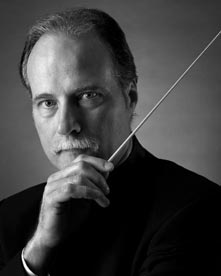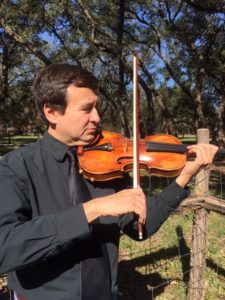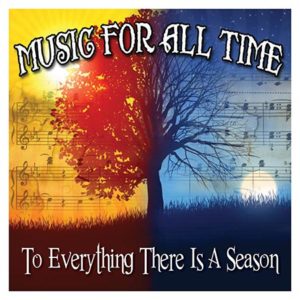Concert 5
Music for All Time–To Everything There Is A Season
April 25, 2019
Happy Birthday Variations John Towner Williams
Morning, Noon and Night in Vienna Franz von Suppé
Winter and Summer from The Four Seasons Antonio Vivaldi
Philip Johnson, assistant concertmaster, violin solo
The Unanswered Question Charles Edward Ives
Ase’s Death from Peer Gynt Edvard Grieg
The Firebird Suite Igor Stravinsky

Sponsored by Community 1st National Bank
Conductor’s Letter

Gene Dowdy
Conductor & Artistic Director
Dear Symphony of the Hills’ Friends,
Our final concert of the season is filled with music that portrays the different seasons, times, and stages of our existence including birth, life, passing, as well as the hope of things eternal. “Happy Birthday to You,” while a ubiquitously sung verse at birthday parties, and also intensely fought over in a 2016 legal battle certifying public domain, had humble beginnings as an elementary school song sung with the words, “Good Morning to All.” John Williams transcribed this song, cited by the Guinness Book of World Records as the most recognizable song in the English language, into his own brilliant orchestral rendition. We look at entire lifetimes through the lens of a 24-hour period, hence metaphors such as “the dawn of life” and the biological condition known as “sundowning.” Popular classical composer Franz von Suppe wrote an overture inspired by the times of day entitled “Morning, Noon and Night in Vienna.” Fittingly, 2019 is the 200th anniversary of the birth of this greatest Viennese light-opera composer. When it comes to seasons of the year, Antonio Vivaldi composed the most famous of concertos based on the four seasons. We will feature Symphony of the Hills assistant concertmaster Philip Johnson performing “Winter” and “Summer” from Vivaldi’s The Four Seasons.
The second half of our concert begins with another American composer, Charles Ives, who combined innovative ideas in his music. Though largely unknown during his lifetime, Ives became celebrated all over the world as a brilliant composer. His “Unanswered Question” poses a musical reflection on our pursuit to find meaning in life. For the end of our time on Earth, many composers have written profound works that honor and reflect upon life and death. We will feature Edvard Grieg’s intensely emotional composition entitled “Ase’s Death” from his Peer Gynt Suite No. 1. Finally, as a representation of eternal life, Russian composer Igor Stravinsky composed his colorful Firebird Suite, based on a fairy tale about a magical bird that could bring blessings or curses to its owner. At the end of the ballet, the Firebird causes an awakening of those who have fallen asleep, and the music is a thrilling celebration of new life.
We hope to see you at our concert finale, and where we will announce our 2019-20 season!
With sincere thanks for your support,
Gene Dowdy
Conductor & Artistic Director
 Philip Johnson, Violin Soloist
Philip Johnson, Violin Soloist
Philip Johnson began learning violin at the age of 10, studying with symphony players in his hometown of Buffalo, New York. He earned a Bachelor of Music degree in violin performance from the Eastman School of Music in 1982, and a Master of Music degree in violin performance and literature from Baylor University in 1986. His teachers include Bernard and Rivka Mandelkern, Sally Thomas, Charles Castleman, and Kristin Lindley, and he has coached with concertmasters of eight major orchestras. His summer studies include four summers at the Meadowmount School of Music, two summers at the Quartet Program, and one at the Tanglewood Music Institute. Since joining the San Antonio Symphony in 1983, he has been an active performer throughout San Antonio and South Texas. He was Concertmaster of the Mid-Texas Symphony for six years, and from 2004-07 he served as Operations Manager for Youth Orchestras of San Antonio. Since 2009, he has been a member of the adjunct faculty at St. Mary’s University, where he teaches violin lessons, string methods classes, and directs the growing St. Mary’s String Ensemble. He serves as Associate Concertmaster of the Symphony of the Hills, and is active with local freelance playing, sectional rehearsals at area high schools, and private teaching. His wife, Deana, is an oboist, retired high school orchestra director, and youth orchestra conductor; they have three grown children and two grandsons. In (look up the year), Philip and Deana appeared with Symphony of the Hills, performing Bach’s Double Concerto for oboe and violin.
Concert Notes
Summing up a lifetime of music is of course impossible. But tonight we’re going to hit both ends and the middle while showing off the diverse skills of the Symphony of the Hills. This final concert of the season will be a thrilling celebration of life from birth to passing, from dawn to dusk, with selections to provide color across the whole spectrum.
Happy Birthday Variations
John Towner Williams (1932 – )
Those of us who saw the movie Jaws will probably remember experiencing terror. We were pretty sure something bad was going to happen to the next person who went into the water (after they all were told several times not to.) Those feelings stemmed from, or were intensified by, the film score of John Williams.
Williams is an American institution, feted with five Academy Awards, four Golden Globes and 22 Grammys, and was the recipient of the Kennedy Center Honors in 2004. With a career spanning over six decades, John Williams has composed some of the most popular and recognizable film scores in cinematic history, including the Star Wars series, Jaws, Close Encounters of the Third Kind, Superman, E.T., the Indiana Jones series, the first two Jurassic Park films, Schindler’s List, and the first three Harry Potter films. Williams has also composed numerous classical concertos and other works for orchestral ensembles and solo instruments. Over the 17 years of pure enjoyment we have experienced at Symphony of the Hills’ concerts, we have often heard John Williams’ music expertly performed.
Tonight we will be treated to a recent arrangement by Williams: his rendition of that old standby “Happy Birthday,” recorded and released by the Boston Pops in 2012 to honor Williams’ 80th Birthday. There are some amazing surprises in this composition, which showcases individually the sections of the orchestra without losing the well-known melody.
Morning, Noon and Night in Vienna
Franz von Suppé (1819 – 1895)
Franz von Suppé—aka Francesco Ezechiele Ermenegildo Cavaliere Suppé Demelli—was born in Spalato, Dalmatia (now Split, Croatia) to parents who, like so many others before and since, discouraged their son’s aspirations for a musical career. Thwarting the will of his parents, he followed the recommendations of a local bandmaster and choirmaster who realized his real talent. Though he demonstrated promise as a composer at a young age, von Suppé agreed to move with the family to Padua, Italy where he was supposed to study law. His passion was directed elsewhere however. As a teenager in Cremona, Suppé studied flute and harmony. His first extant composition was a Roman Catholic mass, which premiered at a Franciscan church in Zara in 1832. Upon his father’s death in 1835, he relocated to Vienna (with his mother), enrolled in the Conservatory, and pursued his true passion.
Morning, Noon and Night in Vienna belongs to a musical genre that characterizes a piece to precede an operetta, i. e. a humorous play interspersed with song. The overture to such a production is rarely related to the actual story line of the play. The function of the overture was simply to get the attention of the audience, quiet the house and set the scene for the entertainment. Even in this relatively early work, composed when he was only twenty‐four, von Suppé had a feel for how to grab the attention of the audience. The play closed after three nights, but the overture has enjoyed an enormous, and continuing, success.
Winter and Summer from The Four Seasons
Antonio Vivaldi (1678–1741)
Antonio Vivaldi was born in Venice, one of eight siblings. His father, Giovanni Battista Vivaldi, a barber before becoming a professional violinist, taught Antonio to play the violin at an early age and then toured Venice playing the violin with his young son. Antonio was well taught, judging from the extensive musical knowledge he acquired by his early twenties. In furtherance of his musical pursuits, his father was one of the founders of the Venice-based association of musicians, which of course provided Antonio with an excellent environment.
Vivaldi is among the greatest of Baroque composers, and his influence during his lifetime was widespread across Europe. He composed many instrumental concertos for the violin and a variety of other instruments, as well as choral works and more than forty operas. Within the Baroque period, it is interesting to note that Vivaldi and Johann Sebastian never met! While the Italian composer led the life of an international traveler, moving from one lucrative appointment to the next, Bach never strayed from his homeland. Nevertheless, during his tenure as organist to the court of Duke Wilhelm Ernst in Weimar, Bach was constantly exposed to the music of Vivaldi; scholars have suggested that this exposure to Vivaldi’s music presented the strongest single development towards Bach’s personal musical style.
This evening we will hear two concertos from Vivaldi’s best-known work, The Four Seasons. Composed in 1725, this piece is among the most popular in the classical music repertoire, excerpts of which constantly appear as background music in movies and television. The texture of each concerto is varied, each resembling its respective season. For example, “Winter” is peppered with silvery pizzicato notes from the high strings, calling to mind icy rain, whereas “Summer” evokes a thunderstorm in its final movement (which is why the movement is often called “Storm.”) With instructions from Vivaldi in the music’s score to play “like a barking dog” or “like a sleeping goatherd,” performers have to use their imagination to achieve the sound Vivaldi had in mind.
The Unanswered Question
Charles Edward Ives (1874 – 1954)
Charles Edward Ives was a composer in the American modernist mode. He is one of the first American composers of international renown, although his music was largely ignored during his life, and many of his works went unperformed for many years. Ives was among the first composers to engage in a systematic program of experimental music, with musical techniques including polytonality, polyrhythm, tone clusters, random (or accidental) elements and quarter tones, foreshadowing many musical innovations of the 20th century.
The Unanswered Question: What is the meaning of life? Ives stated that the quiet strings you hear at the beginning of this piece, which continue throughout, represent the “silence of the Druids” who know everything and observe everything but say nothing, so the question goes unanswered. The strident and discordant trumpet solo represents the human being who asks the perennial question of existence. The woodwind quartet represents those who try to provide the answer, but who fail to come up with one, and they grow more and more dissonant as they continue, representing disagreement and argument among those trying to answer the question — eventually their dissonance is extreme and they give up. Charles Ives was attempting to express in music that unanswered question of life, “Why am I here?” Alexa and Siri don’t have the answer either.
Ase’s Death from Peer Gynt
Edvard Grieg (1843–1907)
Edvard Grieg has become a favored composer of romantic classical music. For more than a century, his imaginative musical style in the Norwegian romantic folk tradition has had preeminent status in the international classical repertoire.
At the request of the Norwegian dramatist Henrik Ibsen, during the period 1874–6 Grieg composed the Peer Gynt Suite No. 1 for the1876 premiere of Ibsen’s play of the same name. The music debuted to immediate acclaim and has been a classical standby ever since. The play, based on Norwegian folklore, explores and satirizes the national culture through the exploits of its charismatic title character, Peer Gynt. Peer is a Norwegian peasant who impulsively abducts a bride from her wedding and then abandons her in order to travel the world. Grieg was put off by the irreverence of the play but he nevertheless expended a monumental effort to complete the music in a timely way.
Most would agree that Death of Åse (Åse is Peer’s Mom) is their favorite composition in the Peer Gynt Suite. What makes this such a beautiful piece are the slow, climbing chords that open the piece, the pattern repeated a fifth higher, and the pattern in reverse, creeping downwards chromatically. We don’t know whether Grieg meant these sequences to represent Åse’s last breath or an ascent into heaven, but they’re serene, sorrowful, beautiful and mesmerizing.
The Firebird Suite
Igor Stravinsky (1845 – 1924)
The Firebird is a fantastic, exciting, immensely popular ballet and orchestral work by the Russian composer Igor Stravinsky. It was written for the 1910 Paris season of Sergei Diaghilev’s Ballets Russes. The ballet, a perennial favorite among major ballet companies throughout the world, was based on the Russian fairy tales of the Firebird and the blessing and curse it possesses for its owner. When first performed at the Opéra de Paris on 25 June 1910, the work was an instant success with both audience and critics.
Igor Stravinsky was the son of Fyodor Stravinsky, a principal musician at the Imperial Opera in St. Petersburg, Russia, and Anna Kholodovskaya, a competent amateur singer and pianist from an aristocratic Russian family. As a result of his father’s association with many of the leading figures in Russian music, including Rimsky-Korsakov, Borodin and Mussorgsky, Igor grew up in an intensely musical environment. In 1901, Stravinsky began to study law at St Petersburg University, while taking private lessons in harmony and counterpoint. He worked under the guidance of Rimsky-Korsakov, who was impressed with Igor’s talents. By the time of his mentor’s death in 1908, Stravinsky had produced several works.
The Firebird has historic significance not only as Stravinsky’s breakthrough piece, but also as the beginning of the collaboration between Diaghilev and Stravinsky that would produce other acclaimed ballets, e.g. The Rite of Spring (1913). Firebird has been recorded countless times by most noted international orchestras and is instantly recognizable for its usage in the depiction of a violent, flaming volcanic spirit in Disney’s movie Fantasia 2000.
The legend or myth of the Firebird has taken many forms over the millennia, similar in many ways to that of the Phoenix, most often representing rebirth or eternal life. The bird takes a leading role in many Russian or Slavic fairy tales as a glowing, fiery creature of great and desirable beauty. The bird recreates itself in a burst of new life, analogous to springtime, and according us a well-chosen conclusion to this evening’s concert.
Concert Notes by Jim Adams



